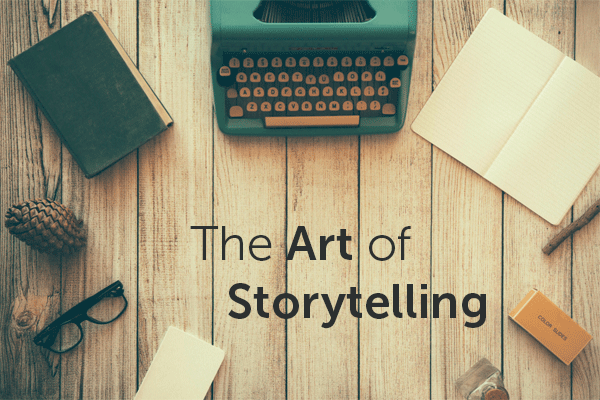One of the most effective marketing strategies for your small business has been around since the beginning of time. Storytelling. Even before the modern digital era storytelling was used by ancient leaders to move crowds to action, preserve history and change nations. Storytelling is a powerful tool that you can use to market your brand and connect in a more real and personal way with your audience.
The Power of Storytelling
“We are, as a species, addicted to story. Even when the body goes to sleep, the mind stays up all night, telling itself stories.” – Jonathan Gottschall (@jonathangottsch), The Storytelling
As a small business, cutting through the noise and getting more of your audience talking about you can leave you feeling like David in a match against Goliath.
Lots of companies create content, and it’s getting crowded out there. Getting attention is tough, unless you can connect with people on a human level and tap into their emotions. Crafting a compelling, memorable story that shows why your business is unique is a powerful way to stamp your brand on the hearts and minds of your audience. Create a story worth sharing, and your audience will reward you by passing it on to their family, friends and colleagues.
But does storytelling really work?
The answer: It sure does.
The reason storytelling is so effective is because the buying process is not just a rational decision backed by data points for your customers; it’s also an emotional one.
In Chip and Dan Heath’s Book, “Made to Stick” they describe why some ideas stick and others don’t. Overwhelmingly the stats show that people remember a powerful story over cited statistics. Stats like the often regurgitated: “We grew revenue by 200 percent.”
In fact, in one example, students at Stanford were asked to share facts with their classmates: 63% remembered the stories and only 5% remembered the actual statistics that were cited.
I know what you’re thinking…if you’re anything like those Stanford students, you probably won’t remember that stat. So to illustrate, here is a great example of a business using storytelling.
Subaru, as you know, is in the car business and like everyone else they could have talked about safety, gas mileage, etc. Instead they connected with their potential buyers and customers with a powerful story, Making Memories:
Now I have to tell you I don’t own a Subaru, but as a dad (their ideal buyer) this pulled on my heartstrings in a way that no other car company has. I have shared this video and nearly 340K people have as well.
But you are probably asking, so what? Is it driving results?
Subaru is outpacing their competitors in growth and recent sales have been up as much as 28% as a result of their focus on leveraging storytelling to connect in a more human way. That’s huge.
The Art of Storytelling
You’re probably thinking, I don’t have a Subaru-sized budget. So how do you craft your own compelling story that captivates the attention of your small business audience?
Start with the 6 Elements of a great story:
- Understand Your Purpose: Whether you sell a product or a service, don’t make the story about what you do, make it about “WHY” you do it. It is often said if you are in the shovel business you don’t sell shovels, you “Give them a better hole”. People gravitate towards the “why” not the “how” or “what.”
- Create the Conflict: If everything is running smoothly for your ideal buyer, what do they need you for? It’s human nature to be slow to embrace change, but a pain-point or point of conflict for your ideal buyer can be the catalyst they need to make a buying decision. Show your readers what problem your product/solution solves and what tension it relieves.
- Create the Character: Develop a character that your reader or audience can relate to and cheer for. Someone that experiences the same challenges and struggles your ideal customer goes through every day.
- Focus on WIFT: Your prospects and customers want to know what’s in it for them. The fact is, no one cares about your business’s sales and marketing goals. Believe it or not, your audience doesn’t wake up every day waiting to be a lead in your sales pipeline. They do, however love hearing and sharing a remarkable story about themselves!
- Keep it simple: We all suffer from overstimulation produced by too much content. Attention spans are short, and everyone reads in 140 character, bit-sized chunks. So, keep your story short, easy to digest and impactful. A great example of simplicity is Apple.
- Deliver a great ending-With a great story, you’ve got readers in the palm of your hand. While you have them engaged, don’t forget to include a clear call to action to help them take the next steps to happily ever after. Describe how doing business with you will improve their lives and emphasize why it’s worth the tradeoff of changing their behavior.
Bonus-6.1 Share your story: Now, more than ever, you have a platform to spread your story. Social tools like Facebook, Twitter, Slideshare, and Instagram make it easy to connect with your prospects in customers in real-time and share an engaging story. Social media is also a great place to find elements to craft a great story for case studies, your blog and your website.
We are moving into an era where “Personal” Brands will separate themselves from the pack by delivering on authentic and real messages. By using storytelling in your marketing, you give your prospects and customers a reason to care about your business. And to quote the great Mark Cuban: “When you’ve got 10,000 people trying to do the same thing, why would you want to be number 10,001?”
